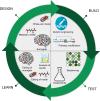Bridging the gap between mechanistic biological models and machine learning surrogates
- PMID: 37079494
- PMCID: PMC10118077
- DOI: 10.1371/journal.pcbi.1010988
Bridging the gap between mechanistic biological models and machine learning surrogates
Abstract
Mechanistic models have been used for centuries to describe complex interconnected processes, including biological ones. As the scope of these models has widened, so have their computational demands. This complexity can limit their suitability when running many simulations or when real-time results are required. Surrogate machine learning (ML) models can be used to approximate the behaviour of complex mechanistic models, and once built, their computational demands are several orders of magnitude lower. This paper provides an overview of the relevant literature, both from an applicability and a theoretical perspective. For the latter, the paper focuses on the design and training of the underlying ML models. Application-wise, we show how ML surrogates have been used to approximate different mechanistic models. We present a perspective on how these approaches can be applied to models representing biological processes with potential industrial applications (e.g., metabolism and whole-cell modelling) and show why surrogate ML models may hold the key to making the simulation of complex biological systems possible using a typical desktop computer.
Copyright: © 2023 Gherman et al. This is an open access article distributed under the terms of the Creative Commons Attribution License, which permits unrestricted use, distribution, and reproduction in any medium, provided the original author and source are credited.
Conflict of interest statement
The authors have declared that no competing interests exist.
Figures



References
-
- Fuller A, Fan Z, Day C, Barlow C. Digital twin: Enabling technologies, challenges and open research. IEEE Access. 2020;8:108952–108971.
Publication types
MeSH terms
Grants and funding
- BB/W013770/1 /BB_/Biotechnology and Biological Sciences Research Council/United Kingdom
- BB/X511997/1/BB_/Biotechnology and Biological Sciences Research Council/United Kingdom
- BB/W013959/1/BB_/Biotechnology and Biological Sciences Research Council/United Kingdom
- BB/W012235/1/BB_/Biotechnology and Biological Sciences Research Council/United Kingdom
LinkOut - more resources
Full Text Sources
Research Materials
Miscellaneous

